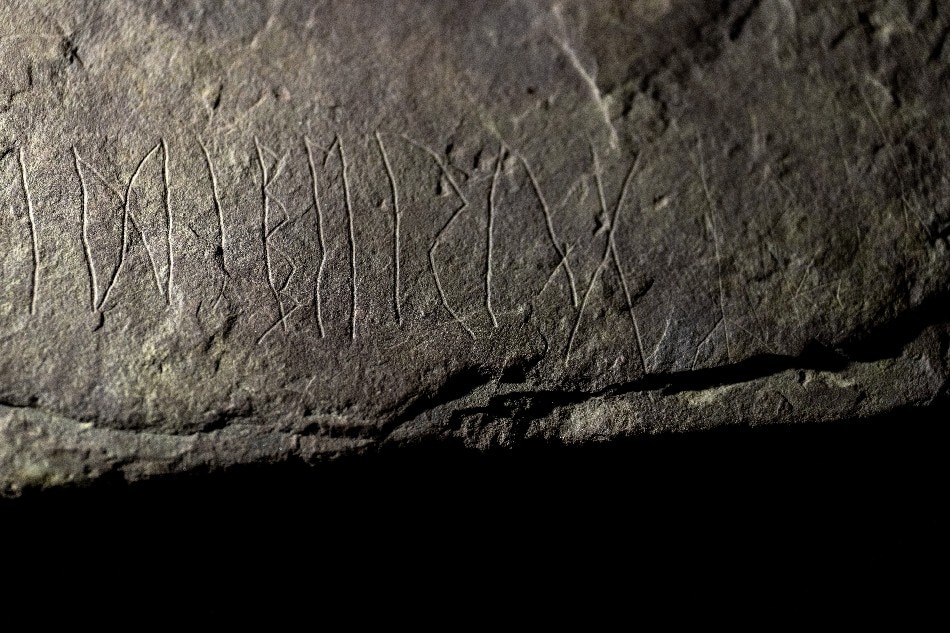Archaeologists find 'world's oldest runestone' in Norway | ABS-CBN
ADVERTISEMENT

Welcome, Kapamilya! We use cookies to improve your browsing experience. Continuing to use this site means you agree to our use of cookies. Tell me more!
Archaeologists find 'world's oldest runestone' in Norway
Archaeologists find 'world's oldest runestone' in Norway
Deutsche Welle
Published Jan 18, 2023 11:53 AM PHT
Archaeologists in Norway on Tuesday said they had found a runestone which they believe is the world's oldest ever discovered.
Archaeologists in Norway on Tuesday said they had found a runestone which they believe is the world's oldest ever discovered.
The flat, square block of sandstone has carved inscriptions which may be the earliest known example of words recorded in writing in Scandinavia, the Museum of Cultural History in Oslo said.
The flat, square block of sandstone has carved inscriptions which may be the earliest known example of words recorded in writing in Scandinavia, the Museum of Cultural History in Oslo said.
It said the stone was "among the oldest runic inscriptions ever found" and "the oldest datable runestone in the world."
It said the stone was "among the oldest runic inscriptions ever found" and "the oldest datable runestone in the world."
Not the oldest known runes, but the oldest on stone
Older runes have been found on other items, but not on stone. The earliest known runic find is on a comb made of bone found in Denmark.
Older runes have been found on other items, but not on stone. The earliest known runic find is on a comb made of bone found in Denmark.
ADVERTISEMENT
"This find will give us a lot of knowledge about the use of runes in the early Iron Age. This may be one of the first attempts to use runes in Norway and Scandinavia on stone," Kristel Zilmer, a professor at the University of Oslo, of which the museum is a part, told the Associated Press (AP).
"This find will give us a lot of knowledge about the use of runes in the early Iron Age. This may be one of the first attempts to use runes in Norway and Scandinavia on stone," Kristel Zilmer, a professor at the University of Oslo, of which the museum is a part, told the Associated Press (AP).
The runestone was discovered in the second half of 2021 during an excavation of a grave near Tyrifjord, to the west of Oslo. The area is renowned for a series of archaeological finds.
The runestone was discovered in the second half of 2021 during an excavation of a grave near Tyrifjord, to the west of Oslo. The area is renowned for a series of archaeological finds.
"We needed time to analyze and date the runestone," Zilmer said.
"We needed time to analyze and date the runestone," Zilmer said.
According to the researchers, items in the cremation pit — such as burnt bones and charcoal — suggest that the runes were likely inscribed between A.D. 1 and 250.
According to the researchers, items in the cremation pit — such as burnt bones and charcoal — suggest that the runes were likely inscribed between A.D. 1 and 250.
Speaking to Norwegian media, Zilmer said that until now, there had been a broad consensus that the first runes on stone might have been carved between the years A.D. 300 and 400.
Speaking to Norwegian media, Zilmer said that until now, there had been a broad consensus that the first runes on stone might have been carved between the years A.D. 300 and 400.
ADVERTISEMENT
Northern European alphabet prior to Latin's spread
The stone measures roughly 31 by 32 centimeters (or around 1 square foot) and has several types of inscriptions, some of which do not have a clear meaning to the academics.
The stone measures roughly 31 by 32 centimeters (or around 1 square foot) and has several types of inscriptions, some of which do not have a clear meaning to the academics.
Eight runes on the stone read "idiberug," which the archaeologists believe is likely the name of a man, woman, or family.
Eight runes on the stone read "idiberug," which the archaeologists believe is likely the name of a man, woman, or family.
Zilmer told AP the discovery was "the most sensational thing that I, as an academic, have had," saying there was still much more work that could be done to try to understand more about the object.
Zilmer told AP the discovery was "the most sensational thing that I, as an academic, have had," saying there was still much more work that could be done to try to understand more about the object.
"Without doubt, we will obtain valuable knowledge about the early history of runic writing," she said.
"Without doubt, we will obtain valuable knowledge about the early history of runic writing," she said.
The stone will go on display for a month at the Museum of Cultural History in Oslo, starting on January 21. The building holds Norway's largest collection of historical artifacts, from the Stone Age through to modernity.
The stone will go on display for a month at the Museum of Cultural History in Oslo, starting on January 21. The building holds Norway's largest collection of historical artifacts, from the Stone Age through to modernity.
ADVERTISEMENT
Runes were the characters in several Germanic alphabets prior to the advent of the Latin alphabet. The most common of these is also called futhark, after the first letters of the alphabet. To the same token, the word alphabet hails from alpha and beta — for a and b.
Runes were the characters in several Germanic alphabets prior to the advent of the Latin alphabet. The most common of these is also called futhark, after the first letters of the alphabet. To the same token, the word alphabet hails from alpha and beta — for a and b.
ADVERTISEMENT
ADVERTISEMENT



